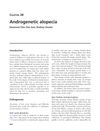bye fellas, it’s time to quit this sub Progress Pictures 4/6/2024
A user successfully improved their hairline after 15 months using topical minoxidil and dutasteride. Some commenters question the necessity of treatment given the user's original hair condition, while others support early intervention.
View this post in the Community →
Similar Community Posts Join
6 / 1000+ resultscommunity Rare Non responder to Finasteride, Dutasteride, and oral minoxidil
A user did not respond to finasteride, dutasteride, and oral minoxidil for hair loss after four years of treatment and is considering scalp micropigmentation (SMP). Other users suggest the hair loss pattern may indicate alopecia areata and recommend seeing a dermatologist.
community COMPLETE OVERVIEW of the Treatment of androgenetic alopecia in men
Male androgenetic alopecia is commonly treated with topical minoxidil and oral finasteride, both requiring continuous use. Other options include hair restoration surgery, dutasteride, light therapy, and camouflaging agents.
community Hair much worse after 6 months?
A user experienced significant hair loss after 6 months of using 0.5mg finasteride daily. Suggestions from others included trying Dutasteride and Minoxidil, getting professional help from a dermatologist, and addressing high iron levels that could be contributing to the hair loss.
community It’s over. NOTHING has worked.
A user who has been trying various treatments for hair loss for four years, with no success. Suggestions include use of minoxidil, finasteride, RU58841, microneedling, supplements and multivitamins, lifestyle changes, scalp biopsy, and SMP.
community Male pattern baldness, and mental health
A 48-year-old man has been using minoxidil for 15 years and considered finasteride but stopped due to potential side effects. He is concerned about his mental health and the impact of hair loss on self-image, and he encourages support among men experiencing hair loss.
community #BIG4 plus vitamins and biotin/ 6 Months results/ 26 years old/ Extreme MPB
A 26-year-old with extreme male pattern baldness saw hair regrowth after 6 months using Minoxidil, Finasteride, microneedling, Nizoral, a vitamin complex, biotin, and a shampoo with baicapil. Continuation of treatment is necessary to maintain results; stopping may lead to hair loss, making a hair transplant a potential future option.
Related Research
6 / 1000+ results
research Nonsurgical Therapy for Hair Loss
Some nonsurgical hair loss treatments are effective, especially if started early.

research Androgenic Alopecia: Case Study and Treatment Analysis
Androgenic Alopecia, a common hair loss condition, can be effectively treated with finasteride and other treatments.

research Overactive Bladder in Men: Finasteride for Androgenetic Alopecia
Finasteride increases hair count and improves hair growth with low risk of side effects.

research A Review of the Treatment of Male Pattern Hair Loss
Finasteride and minoxidil work best together for hair loss.

research Male Pattern Baldness: Causes, Treatments, and Future Prospects
Most American men experience hair loss by age 50, with limited effective treatments available and new options not expected soon.

research Prescribing Habits for Androgenic Alopecia Among Dermatologists in Spain in 2017: A Cross-Sectional Study
In 2017, Spanish dermatologists commonly prescribed topical minoxidil, oral finasteride, and nutricosmetics for hair loss, with oral contraceptives also used for premenopausal women. Less common were oral dutasteride, due to side effects, and newer, more expensive treatments like topical finasteride and Low-Level Laser Therapy. The conclusion is that there's a need for prescription guidelines due to varied treatment approaches.